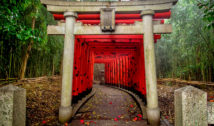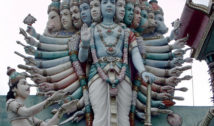Setsubun-sai: Japan’s New Year’s Bean Throwing Celebration
- By C Barnett --
- 02 Feb 2017 --
Shinto traditions of the Setsubun-sai festival.
Setsubun-sai (seasonal division) is an ancient Shinto celebration that marks the start of the Japanese New Year.[/tweetit] Shinto is the native religion of Japan and means “Way of the Gods”. Celebrated every year on February 3, it marks the end of Kan, the coldest season and marks the new Spring season. The day comes before Rishhun, which is the first day of Spring in the Japanese old Lunar calendar.
Setsubun-sai: Japan’s New Year’s Bean Throwing Celebration[/tweetthis]
While Setsubun-sai is not regarded as a national holiday in the country, many people at home or in public spaces will mark the event and celebrate at Shinto shrines and Buddhist temples. Celebrities and other eminent personalities will also take part in the celebrations, with at least 100 million people expected to observe Setsubun-sai either wholly or in part.
Setsubun-sai involves many rituals and practices that are performed to usher in a new season and a New Year. The main event is the mame-maki, which means ‘bean scattering’. The mame-maki is geared towards driving out spirits considered to be evil and to root out any elements of misfortune that may ruin the New Year for a particular family or community. It is also performed to solicit the Gods for good fortune and favor in the new season.
In mame-maki, soybeans are roasted to symbolize the sealing of any evil and prevention of re-emergence of the same in the new year. The home or public space in which the ritual is being performed is then purified by the scattering of the beans while the following phrase is chanted, “Oni wa soto, fuku wa uchi!" This is Japanese for, “Demons out! Luck in!”
Other customs and activities performed during Setsubun include:
- The Yakikagashi
- Eating uncut Mazikushi
- Role reversal
- Morality plays by the tabi geinin
In the Yakikagashi, grilled sardine heads are hung in holly branches all over the points of entry of the house or public space. This is done in the belief that the pungent smell of the sardine and the thorns of the Holly branches will ward off evil in the New Year. The eating of uncut makizushi is meant to curry favor with the Gods and bring good luck. Children and adults also engage in role reversal, with children dressing and acting like adults, while the old act like young children. Others will wear disguises or cross-dress. Morality plays by traveling entertainers are believed to be instrumental in warding off and transporting evil spirits when the entertainers move from one locale or region to the next.
"Demons Out, Luck In!" What is Setsubun? | Taiken Japan https://t.co/HSeq4fgzAR
— Monique Benneker (@Bennek01) February 1, 2017



















